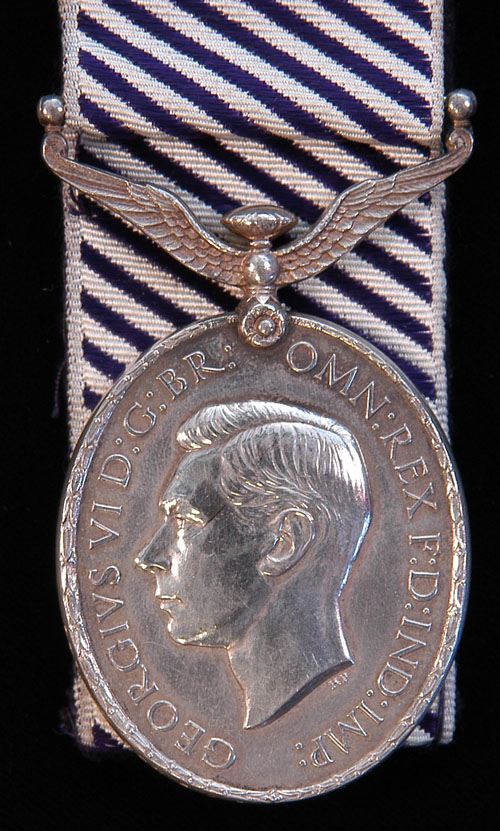
Auction: 6007 - Orders, Decorations, Campaign Medals & Militaria
Lot: 389
An ´Immediate´ Bomber Command Evader´s D.F.M. to Halifax ´S´ for Sugar Air Gunner Sergeant R.H.D. Wilson, No.35 Squadron, for the Courageous Low Level Attack on the German Battleship Tirpitz in the Aas Fjord, Trondheim, April 1942; the Operation was Carried out at 150 Feet in the Face of Intense Opposition from the Tirpitz and from Gun Batteries Both Sides of the Fjord; his Aircraft, Seriously damaged by Flak, was Superbly Force-Landed on a Small Lake and the Crew Quickly Made Their Escape Avoiding the Many German Search Parties from Trondheim; Walking Through Very Deep Snow for Eight Days the Captain and his Crew Crossed the Norwegian Border into Sweden Distinguished Flying Medal G.VI.R., 1st ´Ind: Imp:´ type (633143. Sgt. R.H.D. Wilson. R.A.F.), extremely fine Estimate £ 2,400-2,800 D.F.M. London Gazette 25.5.1943. 633143 Sergeant Ronald Horace David Wilson, No. 35 Squadron, jointly listed with Can/R. 56057 Sergeant Joseph Pierre Gaston Blanchet, No. 35 Squadron. The joint Recommendation, for Sergeant Perry (Bar to D.F.M.), Sergeant Blanchet, and Sergeant Wilson, dated 10.5.1942, states ´Pilot Officer MacIntyre and the above mentioned N.C.O.´s were detailed as a crew to attack the German battleship "Tirpitz" in the Aas fjord at Trondheim on the night of 27th April 1942. This flight involved a total flying time of nine hours and covered a distance of 1,350 miles over the North Sea and the mountainous country of Northern Norway. The attack was ordered to be carried out at 150 feet in the face of intense opposition from the battleship and the guns on both sides of the fjord. It would appear that whilst carrying out this courageous attack, Pilot Officer MacIntyre´s aircraft must have been fatally damaged by flak, necessitating a forced landing in this most difficult country. By a feat of most superb airmanship, this landing was carried out successfully. Having carried out this forced landing, Pilot Officer MacIntyre and the above N.C.O.´s then made their escape from the numerous search parties that had been sent out by the German garrison in Trondheim. For eight days the members of the crew suffered the greatest hardships, walked through deep snow and crossed the mountains, and in an exhausted condition arrived at the Norwegian border, having covered a total distance of 45 miles. By sheer determination and will-power, they crossed safely into Sweden. For this outstanding example of god airmanship on the part of the captain, initiative and devotion to duty on the part of the whole crew, Pilot Officers MacIntyre and Hewitt are strongly recommended for the immediate award of the D.F.C., and Sergeants Blanchet, Perry, and Wilson, the Distinguished Flying Medal.´ Flying Officer MacIntyre´s and Pilot Officer Hewitt´s joint Recommendation for the D.F.C. adds more detail and states ´One night in April 1942 Flying Officer MacIntyre and Pilot Officer Hewitt were captain and navigator respectively of an aircraft detailed to carry out a low level attack on the German naval base at Trondheim. The target was located and, in face of intense of opposition from the enemy´s ground defences, the attack was pressed home with great coolness and determination from a low level. During this operation the aircraft was hit. The outer portion of the wing caught fire and the fuselage and cockpit were filled with smoke. Soon the aircraft was well alight and as it became uncontrollable Flying Officer MacIntyre decided to descend onto a lake to which he was directed by Pilot Officer Hewitt. This he achieved by a feat of superb airmanship. The crew then manned their dinghy and made their way to the side of the lake. After a perilous journey and suffering great hardships, Flying Officer MacIntyre and his crew eventually reached England. The greatest credit is due to both these officers for their calm efficiency and courageous devotion to duty.´ Sergeant Ronald Horace David Wilson, D.F.M., born Yeovil, 1920; enlisted Royal Air Force, 1939; flew as Air Gunner with 35 Squadron (Madras Presidency) Squadron, Linton-on-Ouse (Halifaxes), 1942; Wilson was to be in one of eleven Halifax crews from the squadron to work in conjunction with aircraft from 10 and 76 Squadrons, for a raid on the Tirpitz, 27.4.1942 (see Recommendation); he took off in Halifax II WI048 TL-S (S-Sugar), piloted by Pilot Officer MacIntyre, in what was to be her maiden and indeed last raid, ´Took off 2030 Kinloss. Hit by flak in the target area, which started fire in the starboard wing. P/O MacIntyre retained control, skilfully crash-landing on an ice covered lake near Hocklingen, Norway. Sgt. Stevens sustained a broken leg and was unable to make good his escape with rest of his crew. Following the crash landing, the burning Halifax melted the ice and settled on the bottom of the lake. From here in 1973, the near complete wreck was recovered and has since been put on display in the R.A.F. Museum Hendon. It is believed to be the only genuine Halifax bomber in existence.´ (Bomber Command Losses of the Second War, refers)
Sold for
£5,000




